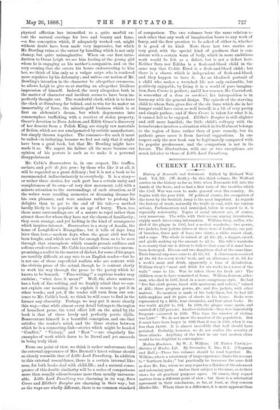CURRENT LITERATURE.
History of Newcastle and Gateshead. Edited by Richard Wel- ford. Vol. III. (W. Scott.)—In this third volume, Mr. Welford carries on the history as far as 1640, when Newcastle fell into the hands of the Scots, and so had a first taste of the troubles which the Civil War was soon to make general over the country. He begins with the year 1561. Of political events, the occupation of the town by the Scottish Army is the most important. As regards the history of trade, naturally the traffic in coal, with the various actions, Parliamentary and municipal, taken in regard to it, is especially noteworthy. Topics of social interest are, of course, very numerous. The wills, with their accomi anying inventories, supply much interesting information. William Grey, miller, who died of the plague in 1585, had a modest wardrobe,—two gowns, two jackets, four jerkins (three of these were of leather), one pair of breeches, three pair of hose, two shirts, a white russet cloak, and a cape. The whole is valued at £1 19s. 2d., a dagger, sword, and girdle making up the amount to £2 Is. His wife's wardrobe is so scanty that one is driven to believe that some of it must have been destroyed. His son and two daughters died at the same time. Their funeral expenses came to £5 17s. 6d. A charwoman received £1 18s. 6d. for seven weeks' work, and an allowance of 2s. 611. for a week's meat and drink, apparently a time of disinfection. William Grey's 't meat and drink for six weeks in a tower of the walls" came to 15s. Was he taken there for fresh air ? The children seem to have remained at home. William Jenison, alder- man, who died in 1587, lived in a more sumptuous style. He had " five fine cloth gowns, faced with 'macrons and velvets," valued at £32 ; three grogram gowns, £8 ; and five jackets, with other matters. No mention is made of his body-linen, but he had 123 table-napkins and 38 pairs of sheets in his house. Books were represented by a Bible, four chronicles, and four great books. He was worth £4,259 ls. 10d. In 1589, the plague came again, and carried off 1,727 persons. Another visitation—they were lamentably frequent—oecurred in 1636. This time the number of victims was 7,000." We do not know the number of the population. But it must have been larger in 1636 than it was in 1548, when it was less than 14,000. It is almost incredible that half should have perished. Probably, however, we do not realise the severity of these attacks. Anything of the kind in our vast modern cities would be too frightful to contemplate.


































 Previous page
Previous page